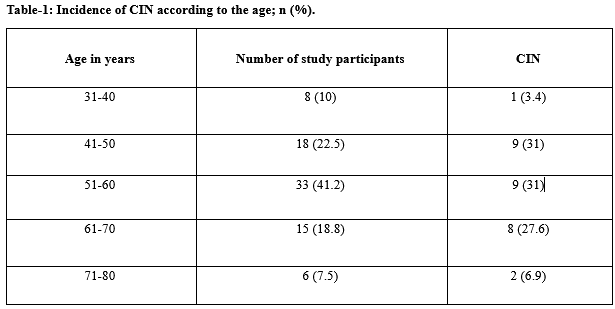Incidence of contrast induced nephropathy among patients undergoing coronary interventions
Abstract
Background: Contrast media (CM) used during diagnostic and therapeutic percutaneous procedures is eliminated by the kidneys. A study has been planned to find the adverse effects of contrast agents on renal system.
Methods: This was a hospital based cross sectional study, conducted in the department of general medicine, GSL Medical College. Individuals >25 age, both gender with heamoglobin concentration of > 10mg/dl were included. Exclusion criteria was also followed. Iodixanol or iohexol was used, administered at the rate of 80 – 100 ml per participants. Blood samples were collected standard techniques before the procedure and 48 hours after the procedure for serum creatinine levels. Renal function was assessed by estimating creatinine clearance using the Cockcroft-gault formulae. As per national kidney foundation participants were divided in to 4 categories normal, mildly impaired, moderately impaired and severely impaired renal function; p<0.05 was considered as statistically significant.
Results: Out of 80 study subjects, CIN was increased with age, identified in 37.9% diabetics, 48.3% smokers, 41.4% alcoholics; statistically there was no significant difference. In the normal category 34.5%, 41.4% in mild category, 24.1% in moderate renal dysfunction category developed CIN, association was statistically significant.
Conclusions: With these findings we conclude that overall increase in the incidence of CIN with age and no influence of gender as well as conditions like diabetes and hypertension.
Downloads
References
Katzberg RW. Urography into the 21st century: new contrast media, renal handling, imaging characteristics, and nephrotoxicity. Radiol. 1997;204(2):297-312. doi: https://doi.org/10.1148/radiology.204.2.9240511.
Weisbord SD, Chen H, Stone RA, Kip KE, Fine MJ, Saul MI, et al. Associations of increases in serum creatinine with mortality and length of hospital stay after coronary angiography. J Am Soc Nephrol. 2006;17(10):2871-2877. Epub 2006 Aug 23. doi: https://doi.org/10.1681/ASN.2006030301.
McCullough P. Outcomes of contrast-induced nephropathy: experience in patients undergoing cardiovascular intervention. Catheter Cardiovasc Interv. 2006; 67(3):335-343. doi: https://doi.org/10.1002/ccd.20658.
Persson PB. Contrast-induced nephropathy. Eur Radiol. 2005;15(4):D65-D69. doi: https://doi.org/10.1007/s10406-005-0113-x.
McCullough PA, Adam A, Becker CR, Davidson C, Lameire N, Stacul F, et al. Epidemiology and prognostic implications of contrast-induced nephropathy. Am J Cardiol. 2006;98(6):5-13. doi: https://doi.org/10.1016/j.amjcard.2006.01.019.
McCullough PA, Wolyn R, Rocher LL, Levin RN, O'Neill WW. Acute renal failure after coronary intervention: incidence, risk factors, and relationship to mortality. Am J Med. 1997;103(5):368-375. doi: https://doi.org/10.1016/j.amjcard.2006.01.019.
Cockcroft DW, Gault MH. Prediction of creatinine clearance from serum creatinine. Nephron. 1976;16(1):31-41. doi: https://doi.org/10.1159/000180580.
Gault MH, Longerich LL, Harnett JD, Wesolowski C. Predicting glomerular function from adjusted serum creatinine. Nephron. 1992;62(3):249-256. doi: https://doi.org/10.1159/000187054.
Kopple JD. National kidney foundation K/DOQI clinical practice guidelines for nutrition in chronic renal failure. Am J Kidney Dis. 2001;37(2):S66-S70. doi: https://doi.org/10.1053/ajkd.2001.20748.
National Kidney Foundation. K/DOQI clinical practice guidelines for chronic kidney disease: evaluation, classification, and stratification. Am J Kidney Dis. 2002;39 (2 Suppl 1): S1-266.
Mehran R, Aymong ED, Nikolsky E, Lasic Z, Iakovou I, Fahy M et al. A simple risk score for prediction of contrast-induced nephropathy after percutaneous coronary intervention: development and initial validation. J Am Coll Cardiol. 2004;44(7):1393-1399. doi: https://doi.org/10.1016/j.jacc.2004.06.068.
Gussenhoven MJ, Ravensbergen J, van Bockel JH, Feuth JD, Aarts JC. Renal dysfunction after angiography; a risk factor analysis in patients with peripheral vascular disease. J Cardiovasc Surg (Torino). 1991;32(1):81-86.
Sharma SK, Dubey L, Laudary S, Dhungel S, Ghimire M, Pahari B, et al. Incidence and predictors of contrast induced nephropathy after coronary intervention at College of Medical Sciences Teaching Hospital, Bharatpur. Nepalese Heart J. 2014;11(1):3-11. doi: https://doi.org/10.3126/njh.v11i1.10975.
Maneesha sasidharan, E JAMES, JCM Prasad. Incidence and predictors of contrast-induced nephropathy in patients undergoing percutaneous coronary interventions at an Indian tertiary care center. Indian J Pharm Sci. 2019;81(4):729-736.
Toprak O, Cirit M, Yesil M, Bayata S, Tanrisev M, Varol U, et al. Impact of diabetic and pre-diabetic state on development of contrast-induced nephropathy in patients with chronic kidney disease. Nephrol Dial Transplant. 2007;22(3):819-826. Epub 2006 Nov 7. doi: https://doi.org/10.1093/ndt/gfl636.
Valappil SP, Kunjukrishnapillai S, Iype M, Koshy AG, Viswanathan S, Gupta PN et al. Predictors of contrast induced nephropathy and the applicability of the Mehran risk score in high risk patients undergoing coronary angioplasty—A study from a tertiary care center in South India. Indian Heart J. 2018;70(3):399-404. doi: https://doi.org/10.1016/j.ihj.2017.08.018. Epub 2017 Aug 26.
Mehran R, Aymong ED, Nikolsky E, Lasic Z, Iakovou I, Fahy M, et al. A simple risk score for prediction of contrast-induced nephropathy after percutaneous coronary intervention: development and initial validation. J Am Coll Cardiol. 2004;44(7):1393-1399. doi: 10.1016/j.jacc. 2004. 06.068.
Evola S, Lunetta M, Macaione F, Fonte G, Milana G, Corrado E, et al. Risk factors for contrast induced nephropathy: A study among Italian patients. Ind Heart J. 2012;64(5):484-491. doi: https://doi.org/10.1016/j.ihj.2012.07.007.
Akhtaruzzaman M, Choudhury AK, Khalequzzaman M, Barua SK, Choudhury TA, Hasem S, et al. Impact of low hemoglobin on contrast-induced nephropathy after percutaneous coronary intervention. Cardiovas J. 2012;5(1):30-36. doi: https://doi.org/10.3329/cardio.v5i1.12226.
Priya SV, Jayakumar KP, Jayaprakash VL, George R. Contrast Induced Nephropathy-A study of 850 patients undergoing cardiac catheterization laboratory procedures. Kerala Heart J. 2015;1(1):14-17.



 OAI - Open Archives Initiative
OAI - Open Archives Initiative


